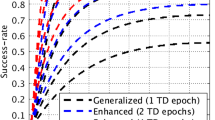A new algorithm has been developed for the determination and elimination of jumps in the Melbourne–Wübbena combination, formed from the code and phase measurements in global navigational satellite systems. The algorithm more reliably, in comparison with analogous known algorithms, detects jumps in the data that are associated with time losses in the radio-receiving devices for phase capture of RF signals transmitted from satellites. Determination of the positions and values of jumps in a Melbourne–Wübbena combination is performed against the noise component and outliers. The algorithm was tested for actual measurements in global navigational satellite systems at two carrier frequencies.


Similar content being viewed by others
References
A. I. Perov and V. N. Kharisov, GLONASS: Principles of Construction and Operation, Radiotekhnika, Moscow (2010), 4th ed.
International GNSS Service, wwv.igs.org/network, acc. Apr. 4, 2018.
R. Dach, F. Andritsch, D. Arnold, et al., Bernese GPS Software, Ver. 5.2, R. Dach et al. (eds.), Astronomical Institute, University of Bern (2015).
W. G. Melbourne, “The case for ranging in GPS based geodetic systems,” in Proc. 1st Int. Symp. Precise Positioning with the Global Positioning System, C. Goad (ed.), US Department of Commerce, Rockville, Maryland (1985), pp. 375–386.
G. Wübbena, Software Developments for Geodetic Positioning with GPS Using Tl 4100 Code and Carrier Measurements, C. Goad (ed.), US Department of Commerce, Rockville, Maryland (1985), pp. 403–412.
G. Blewitt, “An automatic editing algorithm for GPS data,” Geophys. Res. Let., 17, No. 3, 199–202 (1990).
J. Sanz Subirana, M. Juan Zornoza, and M. Hernández-Pajares, Detector Based in Code and Carrier Phase Data: The Melburne–Wübbena Combination. ESA Navipedia, https://gssc.esa.int/navipedia/index.php/Detector_based_in_code_and_carrier_phase_data:_The_Melboume-Wübbena_combination, acc. Jan, 24, 2019.
T. A. Springer, “Modeling and validating orbits and clocks using the Global Positioning System,” in: Geodätisch-Geophysikalische Arbeiten in der Schweiz, Inst. Geodesy and Photogrammetry, ETH Zurich, Zurich (2000), Vol. 60.
I. V. Bezmenov, A. V. Naumov, and S. L. Pasynok, “An effective algorithm for elimination of outliers from data measurements of global navigation satellite systems,” Izmer. Tekhn., No. 9, 26–30 (2018), DOI: 10.32446/0368-1025it.2018-9-26-30.
Author information
Authors and Affiliations
Corresponding author
Additional information
Translated from Izmeritel’naya Tekhnika, No. 5, pp. 25–30, May, 2019.
Rights and permissions
About this article
Cite this article
Bezmenov, I.V., Blinov, I.Y., Naumov, A.V. et al. An Algorithm for Cycle-Slip Detection in a Melbourne–Wübbena Combination Formed of Code and Carrier Phase GNSS Measurements. Meas Tech 62, 415–421 (2019). https://doi.org/10.1007/s11018-019-01639-5
Received:
Published:
Issue Date:
DOI: https://doi.org/10.1007/s11018-019-01639-5




